IS IT REAL? YES, IT IS! Xenia Benivolski on the 2024 Whitney Biennial, New York
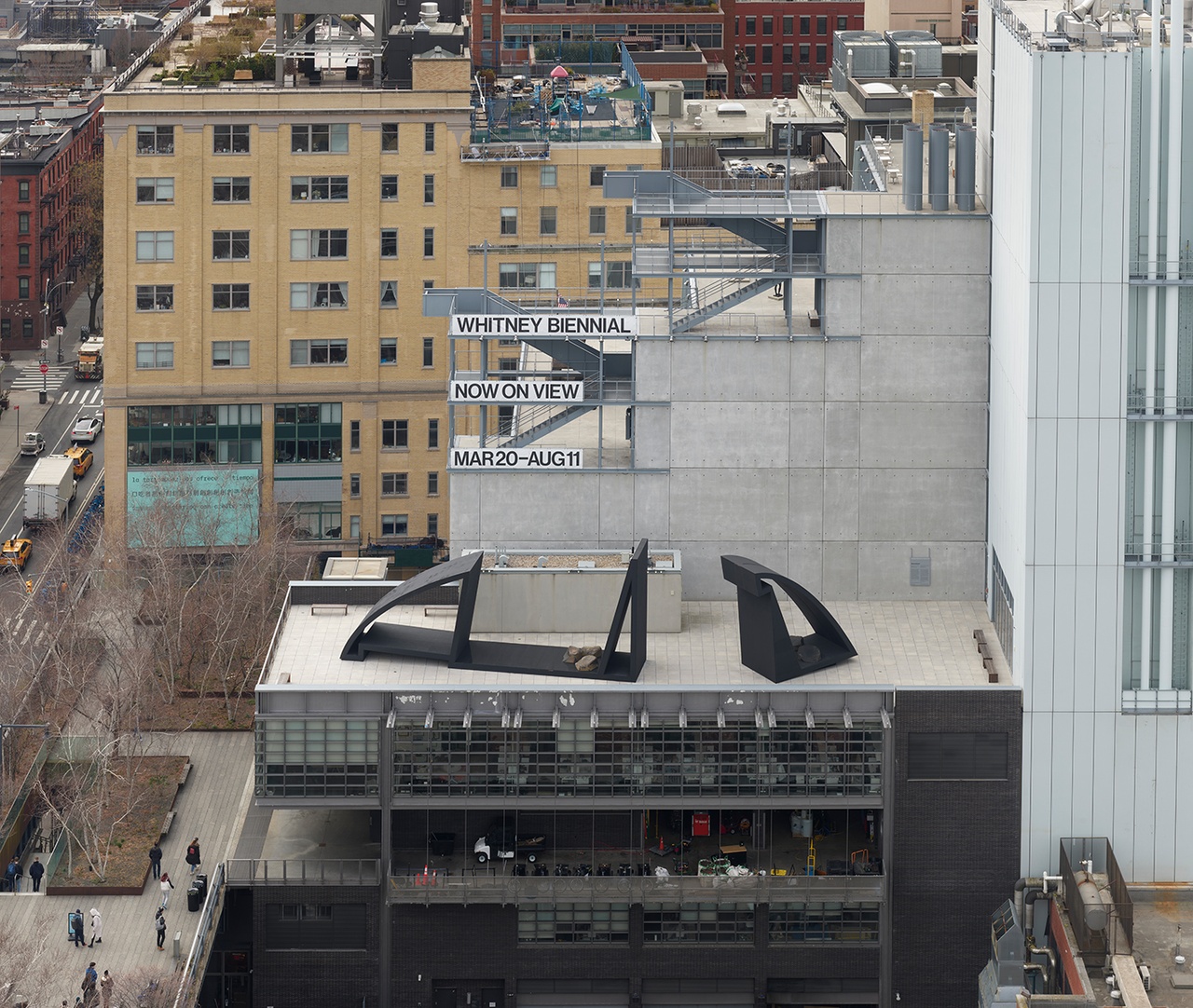
Torkwase Dyson, “Liquid Shadows, Solid Dreams (A Monastic Playground),” 2024
While discussing the 81st Whitney Biennial with a friend, I caught myself falling into the old habit of making assumptions about the exhibition instead of listening, or rather looking, at the works. Not an easy task, since the premise of any American Art survey right now is fickle as hell. The Whitney Biennial is routinely criticized for its overreaching barometric impulse: from the controversial 1993 edition, famously considered to be the identity-politics biennial, to the 2022 exhibition, “Quiet as It’s Kept,” which was already sending distress signals, alarming the viewer of a response fatigue to the very issues it was trying to bring up. In the current edition, entitled “Even Better Than the Real Thing,” curators Chrissie Iles and Meg Onli aim to acknowledge “that Artificial Intelligence (AI) is complicating our understanding of what is real, and rhetoric around gender and authenticity is being used politically and legally to perpetuate transphobia and restrict bodily autonomy.” [1] They do so by carefully positioning closely interrelated artistic and humanistic frameworks in ways that animate vivid overlaps between rather disparate subjectivities: especially through works that concern, in my view, abstraction, metamorphosis, and the body. After three decades of identity-based artistic practice, in a place consumed with variations on truths, from the “truthiness” of the early aughts, to Trump’s outrageous lies, making a show about reality seems like an especially slippery undertaking. No longer are we certain that reality is a realm possessed by something like the truth or even a truth – we’ve come to a place that demands what Hannah Arendt called “the sacrifice of truth for the survival of the world.” [2] Despite its reflective title, “Even Better Than the Real Thing” is not a look in the mirror. Instead, the artists in the exhibition turn inward for answers.
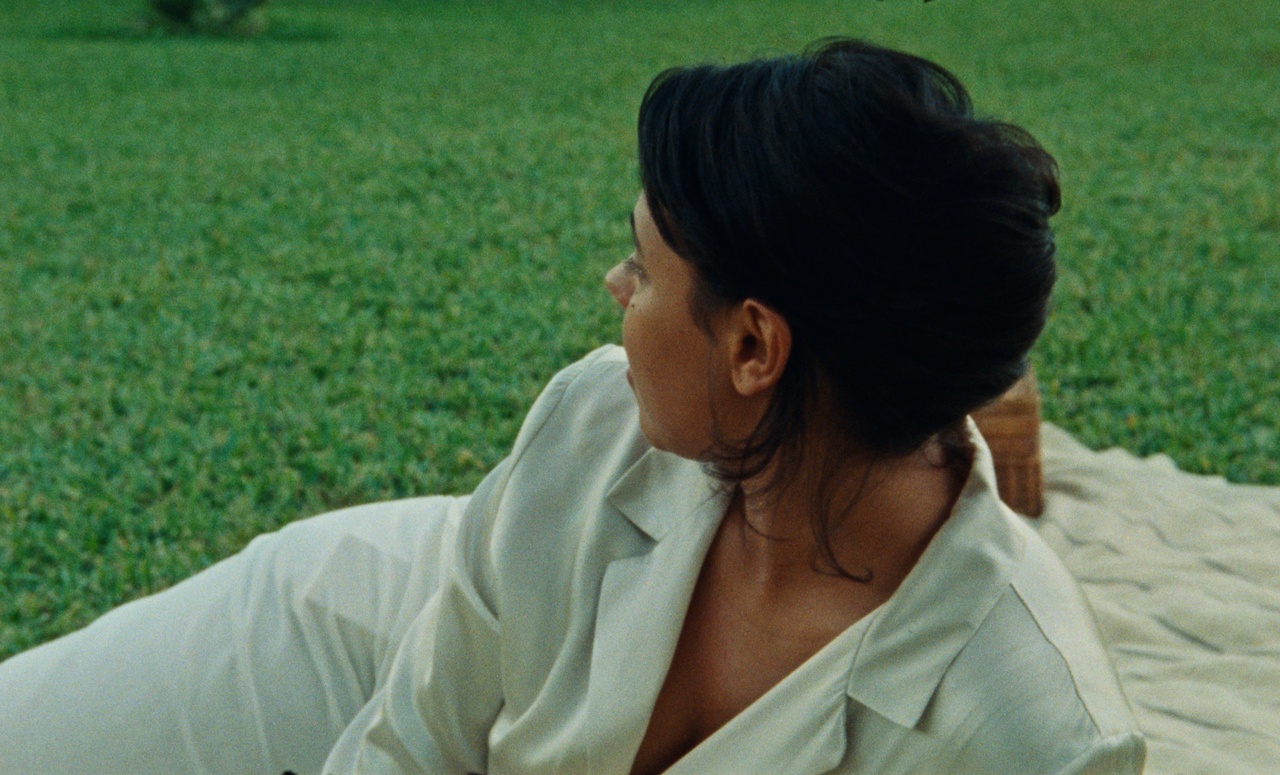
Madeleine Hunt-Ehrlich, “Too Bright to See (Part I),” 2022
Tangible and material connections between works can be easy to miss if one isn’t paying attention. Madeleine Hunt-Ehrlich’s opus Too Bright to See (Part I) (2022) is a video surrounded by a light installation that slowly shifts as its subject metaphorically comes to light. The film loosely follows the story of Suzanne Césaire (1915–1966), a writer, feminist thinker, and pivotal instigator of the Francophone Caribbean philosophy known as Négritude, characterized by its meshing of anti-colonialist politics with Surrealist aesthetics. Despite her outsized role in the movement, Césaire was perhaps better known for her influence on her partners: Martinican poet and politician Aimé Césaire (1913– 2008), French Surrealist André Breton (1896–1966), and the Cuban artist Wifredo Lam (1902–1982). Here, her work appears to claim nature as a metaphorical device that deconstructs hierarchical notions of reality. Loving shots of coastal American and Caribbean landscapes are interspersed with an internal-monologue-type voiceover. Frequent mentions of aborted directions and ideas lead back to the human body and its complex relationship with abstraction, a perceived lack of choices, and a hard nod to gender-based, racially motivated and colonial injustice that echoes throughout the show.
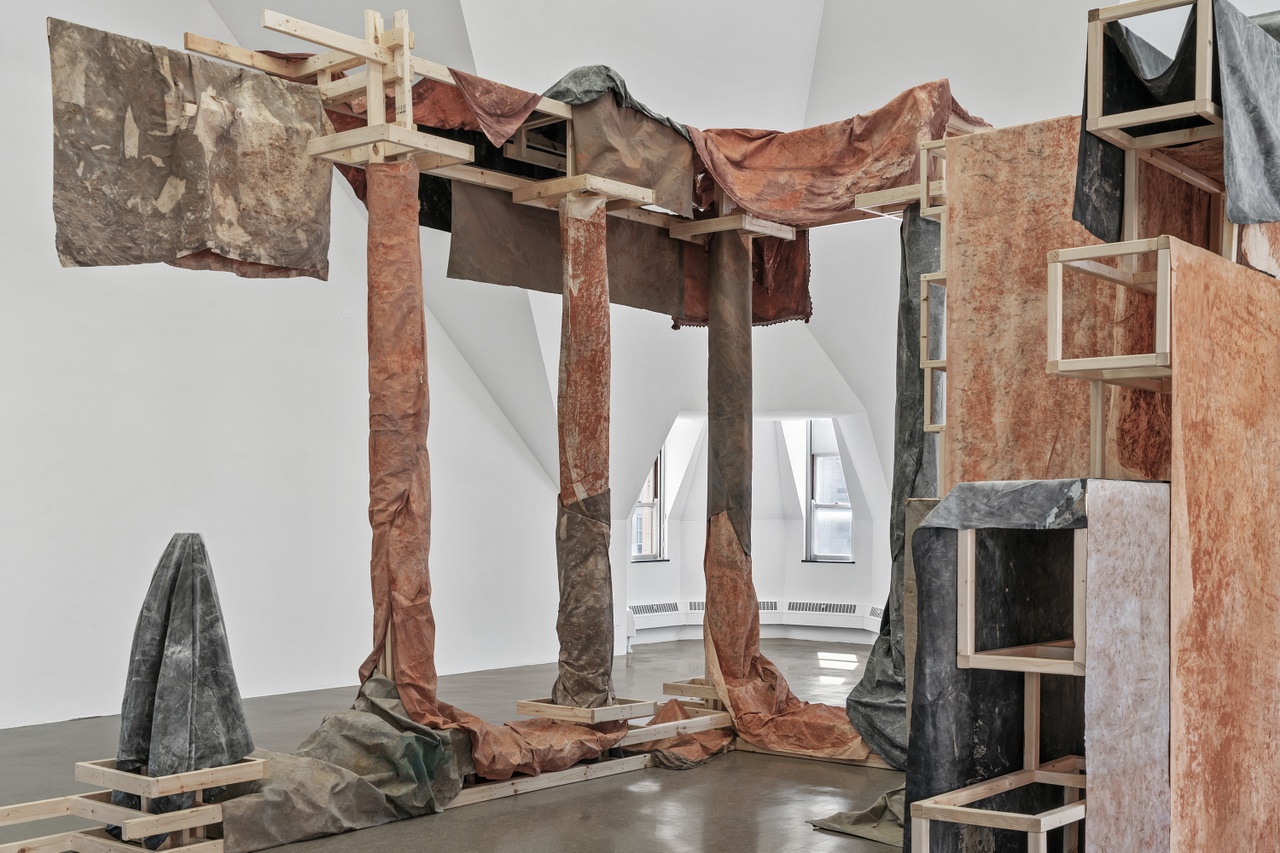
Dala Nasser, “Adonis River,” 2023
For example, Demian DinéYazhi’s neon sign we must stop imagining apocalypse/genocide + we must imagine liberation (2024). Flanked by tourists, phones akimbo, waiting to catch it blink (the sign reveals the words “Free Palestine” in a moment of planned glitch), it’s an apt backdrop to Dala Nasser’s Adonis River (2023), a group of Roman columns wrapped in bedsheets. “Dyed with iron-rich water from the banks of the Abraham River,” [3] the ghostly makeshift paintings conceal their rigid supports while showcasing the vivid composition of the river: according to legend, Adonis, the god of love, was killed nearby. Each February, the water gushes red due to the volume of mineral soil washing off in the winter. The sanguinous flow lends itself to a corporeal metaphor with a temporal dimension: if rivers and creeks are the vascular systems of the Earth, these sheets are essentially blood-stained. A similar idea is baked into the bodies of Lotus L. Kang’s installation In Cascades (2023), a grouping of developing photo paper weighed down with cast aluminum objects. The prints change in time and with exposure to light. Situated in its own room, In Cascades provides relief from the scale of the exhibition. Walking between the cascading auburn evokes a familiar feeling: being in the presence of a sunset or a sunrise, and most peculiarly, the sensation of turning toward the sun with your eyes closed, pulsating red. Multiple works in the exhibition speak to art’s capacity to serve as a document of intangible change, capturing reality as a fleeting moment by collecting material evidence. Among them, Adonis River and In Cascades stand out. While Nasser and Kang linger in the metamorphic moment, Eddie Rodolfo Aparicio’s Paloma Blanca Deja Volar/White Dove Let us Fly (2024), a massive chunk of modified amber with various debris embedded in it, also transforms: peeling off of its supports by the second week of the exhibition, it slowly nods toward the ground – in the artist’s words, “suggesting the ways memory and trauma are held in the body and shift over time.” [4] Some of the debris documents efforts by white activists in the United States trying to promote justice in Central America and Central American communities in the US. Trapped in the translucent resin, they speak to the messy, transparent, and embedded privilege of white allyship.
Often, artists that sit outside of cis-het-whiteness are expected to produce figurative works that disclose their bodies and identities as one of their selling points. A capitalist paradigm of contemporary artistic production limits artists of color and queer artists who seek to work in abstraction, while continuing to capitalize on their bodies. The biennial anchors abstraction within other works that speak to displacement and gentrification, and works that deal directly with the city of New York. Dora Budor’s video and installation Lifelike (2024) examines the alienating effect of corporate architecture, in particular the strange decorative boulders that line the Hudson boardwalk. It is most effective as an accompaniment to Torkwase Dyson’s Liquid Shadows, Solid Dreams (A Monastic Playground) (2024), a large outdoor installation weighed down by the same rocks that anchor Budor’s. Nearby, Mavis Pusey’s large hard-edge abstractions are also inspired by large-scale construction and demolition that took place in New York City: this time in the 1970s, when neighborhoods were demolished to create the World Trade Center. As a Black woman, Pusey struggled to make it as an abstract painter, a challenge that is still sorely felt in many artistic communities excluded from modernist discourses. Ironically, the traditional frameworks that position identity politics at one end of the spectrum and abstraction at another often fail to recognize that abstraction in itself was influenced by non-European cultures. In that sense, when Isaac Julien’s Once Again … (Statues Never Die) (2022) highlights the philosophy of Alain Locke (1885–1954) – a cultural critic of the Harlem Renaissance – it simultaneously enacts a kind of “poetic restitution,” [5] revealing the simplistic ways in which colonial museums have collected African art.
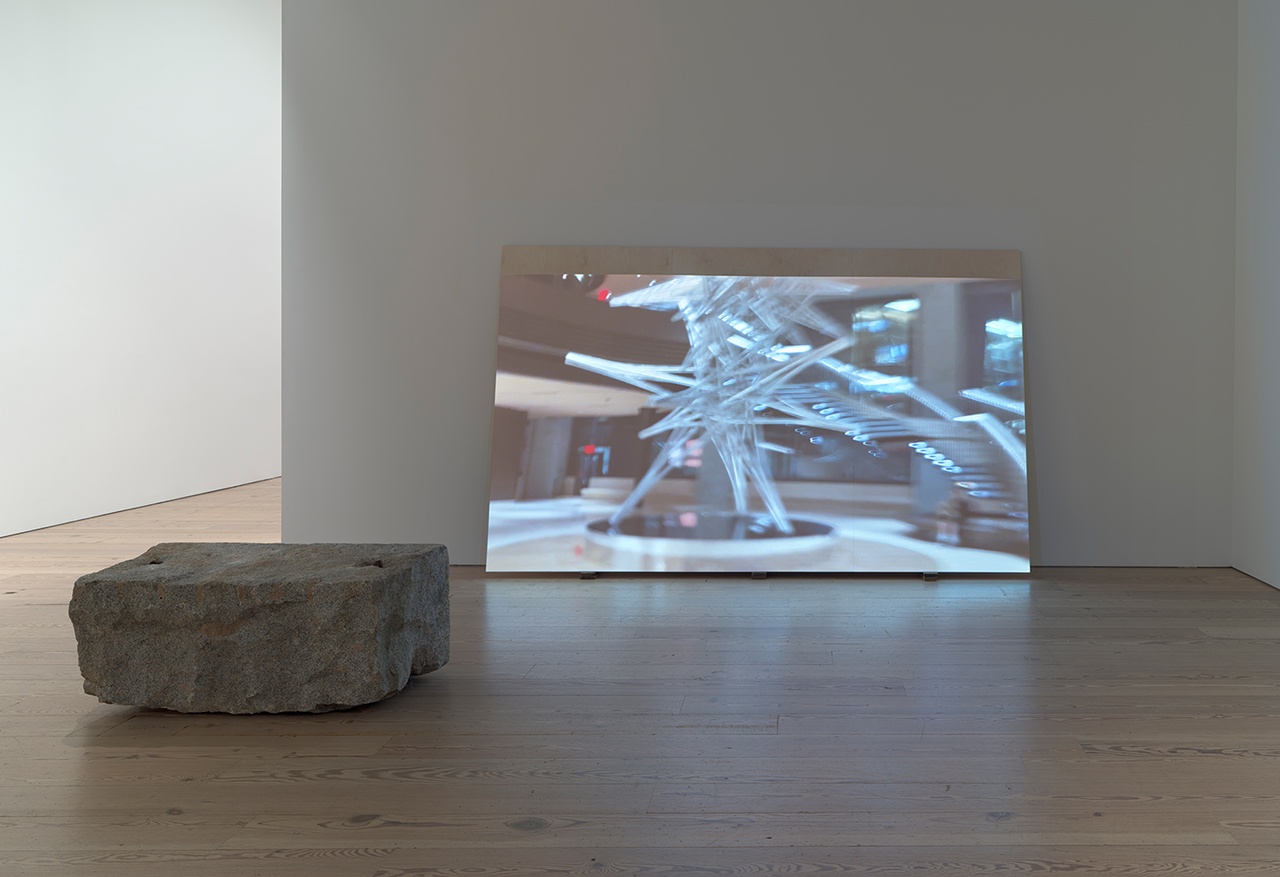
Dora Budor, “Lifelike,” 2024
The question of subjectivity returns in Suzanne Kite’s Pahá kiŋ lená wakháŋ (These hills are sacred) (2017), one of the only works in the show that refers to artificial intelligence, and here in particular concerned with parallels between the temporal philosophies of Lakȟóta people and the perceived subjectivity of non-human beings, which include stones, minerals, animals, and codes. Kite’s work contends with the body as an advanced type of communication device, however, “bodies are never entirely absent from what we refer to as technology,” [6] according to artist Nikita Gale. Gale’s TEMPO RUBATO (STOLEN TIME) (2023–24), a player piano without strings, performs a nearly silent score: articulated through the negative sound-space of the clacking keys, it articulates the formality of its support system – a gesture inverted in Suzanne Jackson’s paintings without canvases, suspended in space. In another room, Takako Yamaguchi’s magnificently sharp, surreal paintings also defy the idea of pure abstraction: Yamaguchi quotes a Wallace Stevens poem to claim that “all of our ideas come from the natural world: trees equal umbrellas.” [7] But somehow, despite the grand poetic proposal of pianos without keys or paintings without canvases, it’s Pippa Garner’s humorous product pitch sketches that speak to me: mounted on a veneer wall, Inventor’s Office (2021) highlights art’s proximity to hobbyism and the absurd twin blunder of authorship and technology in ways that are both humble and real: in particular when proposing contraptions that involve bodies.
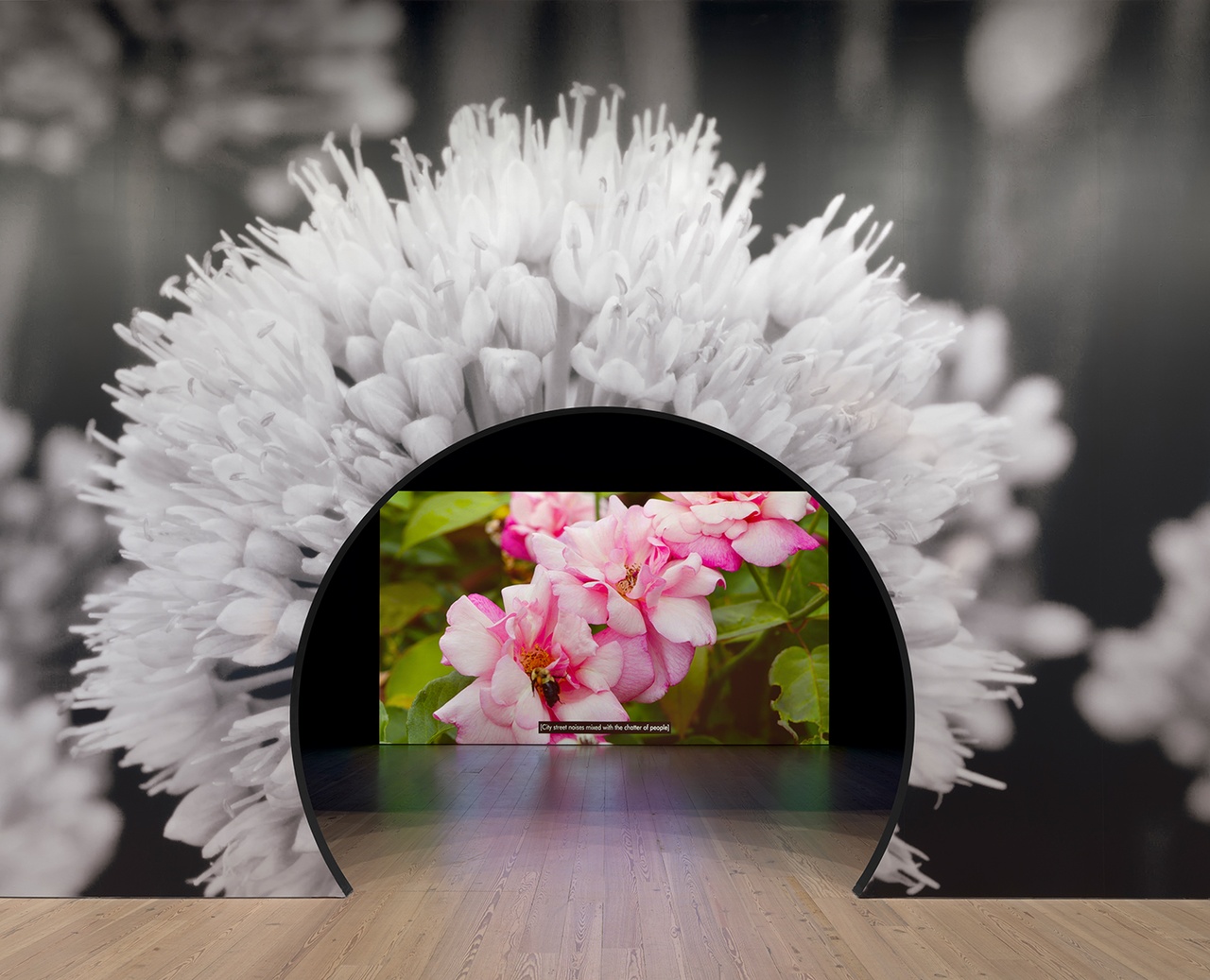
Tourmaline, “Pollinator,” 2022
Indeed, from Hunt-Ehrlich’s hypnotic installation to Kang’s visceral prints, the most successful works were felt in the body. P. Staff’s massive, netted yellow room (Afferent Nerves and A Travers Le Mal, both 2023) creates another distinct sensation: walking in feels a bit like floating, untethered, into space that isn’t quite safe. In their wall text, Staff described the work as “a particular trans mode of being that exists in the tension between dissociation and hypervigilance.” In A Plot, A Scandal (2023), a video installation by Ligia Lewis, bodies reenact disturbing scenarios: various political and mythical vignettes, situations enacted by dancers, capture some of the bodily horrors of colonialism. They remind me of Juanita McNeely’s 1969 painting Is it real? Yes, it is!. In nine terrifying, expressive, snapshot-like frames, the painting tells the story of an illegal abortion: It is a work in the Whitney’s collection that, while not being in the exhibition, is somehow felt throughout. While they no longer dominate the headlines, massive attacks on women’s reproductive rights, the rights of trans people, and the rights of gender non-conforming and non-binary people defined the last two years for the United States. Carmen Winant’s The Last Safe Abortion (2023), a vast tapestry of photographic vignettes from US abortion clinics, taken over the course of the past 50 years, is a grieving echo to McNeely. Tourmaline’s video installation Pollinator (2022), one of the very few in the biennial, draws on the history of Black trans activist and performer Marsha P. Johnson, who often adorned herself with flowers. In the wall didactic, Tourmaline proposes that “the truth of life is its ongoingness, its essence unchanged and unconstrained by space, time, or physical form.” A nice bookend to Hunt-Ehrlich’s work, the video is a dream-like, monologued montage of the artist walking through a garden.
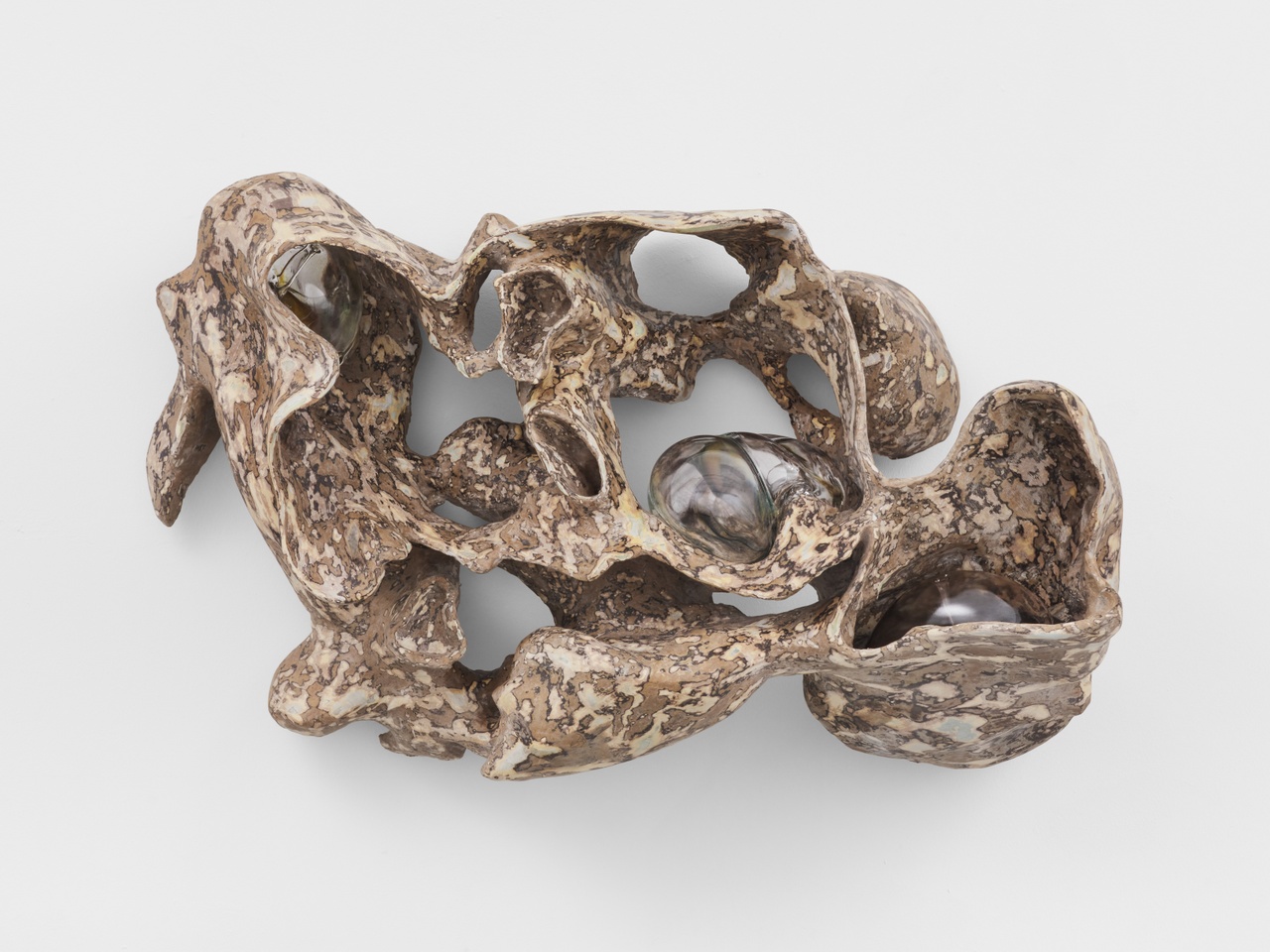
Jes Fan, “Cross Section (Right Leg Muscle III),” 2023
Self-reflection once again turns inward in Julia Phillips’s Mediator and Nourisher (both 2020), two installations where partial casts of the upper body are suspended over reflective surfaces; a microphone, medical tubing, and cabling accompany the forms. Surrounded by her Conception Drawings, they speak to the surreal bodily experience of motherhood, at once transcendent and horrifying. In a series of sculptures entitled Cross Sections (2023), parts of Jes Fan’s own body are mapped, replicated, and displayed. Scanned molds of their interior organs are embedded in the interior space of the wall itself – one can peer inside a replica of Fan’s stomach through a small opening. The color palette is taken from the Aquilaria sinensis, a resinous tree species found in China and Hong Kong, where Fan spent some of their early years. In a close encounter with the inside, the work turns wounds into openings, portals to a vast interiority that somehow turns the exhibition inside out. Standing with one’s back to the entire museum, suspended in this liminal space, and looking inside the wall is a vulnerable escape, simultaneously exposed and protected, almost embryonic. Despite the fact that we all spend much of our time in public engrossed in the portal of the smartphone, with this work, the physical divide between the inside and outside suddenly turned Cartesian: Is it possible to separate the body from the mind, from identity, politics, ambitions, assumptions, and figures? Is it real? Yes, yes it is. While looking into Fan’s Gut (2024), I found myself looking inward, inside myself, forgetting about the museum and lineup behind me. Getting back into the real world seemed unbearable: longing to stay in the feeling, I left immediately, trying not to look at anything on the way out. What makes this world more real than the one I peered into? I don’t know if it is truth, experience, or pure subjectivity that guide the way we understand reality, but I think that, if anywhere, the answers might be inside.
“Whitney Biennial 2024: Even Better Than the Real Thing,” Whitney Museum of American Art, New York, March 20–August 11, 2024.
Xenia Benivolski is a writer, curator, and educator based in Toronto. She writes about visual art, books, and music.
Image credit: 1. Courtesy of Whitney Biennial, photo Ron Amstutz; 2. © Madeleine Hunt-Ehrlich, courtesy of the artist; 3. © Dala Nasser, courtesy of the artist, commissioned by the Renaissance Society, University of Chicago, with support from the Graham Foundation and Maria Sukkar; 4. © Dora Budor, courtesy of the artist and Whitney Biennial, photo Ron Amstutz; 5. © Tourmaline , courtesy of the artist and Whitney Biennial, photo Ron Amstutz; 6. Courtesy the artist, Empty Gallery and Andrew Kreps Gallery, photo Olympia Shannon
Notes
| [1] | Whitney Museum of American Art. “2024 Biennial”. Accessed June 12, 2024. |
| [2] | Hannah Arendt, “Truth and Politics,” New Yorker, February 25, 1967, 49. |
| [3] | From Nasser’s wall text. |
| [4] | Exhibition didactic of Eddie Rodolfo Aparicio, Paloma Blanca Deja Volar/White Dove Let us Fly, 2024, at the Whitney Museum. The text further explains: “Since the chemical structure of the amber has been altered so that it is not completely rigid, the sculpture will change shape over the course of the exhibition as a result of gravity and exposure to ambient light. As it does, the objects within will move, suggesting the ways memory and trauma are held in the body and shift over time.” |
| [5] | From the didactic panel attached to Julien’s work Once Again … (Statues Never Die) (2022) at the Whitney Museum. The full sentence reads: “The installation includes sculptures by Richmond Barthé (1901–1989) and Matthew Angelo Harrison (b. 1989), opening up a conversation about Black artists’ legacies that extends across modern history. Julien has described the work as a form of ‘poetic restitution,’ speaking to the ways museums have collected African art.” |
| [6] | Martha Joseph, “Diabolical Sound: A Conversation with Nikita Gale,” Flash Art, October 26, 2020. |
| [7] | Wallace Stevens, “From the ‘Adagia,’” Poetry 90, no. 1 (1957): 40–44. |
